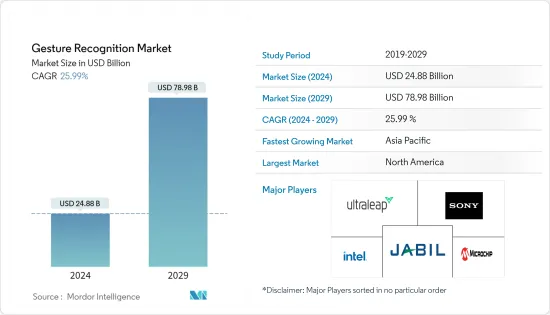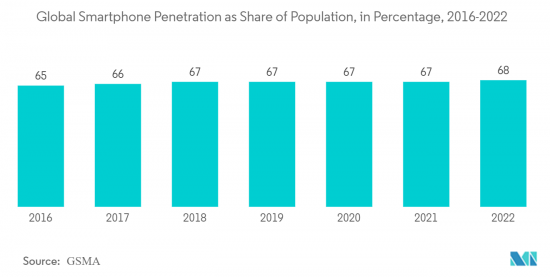 |
市場調査レポート
商品コード
1403086
ジェスチャー認識:市場シェア分析、産業動向・統計、成長予測、2024~2029年Gesture Recognition - Market Share Analysis, Industry Trends & Statistics, Growth Forecasts 2024 - 2029 |
||||||
● お客様のご希望に応じて、既存データの加工や未掲載情報(例:国別セグメント)の追加などの対応が可能です。 詳細はお問い合わせください。
| ジェスチャー認識:市場シェア分析、産業動向・統計、成長予測、2024~2029年 |
|
出版日: 2024年01月04日
発行: Mordor Intelligence
ページ情報: 英文 120 Pages
納期: 2~3営業日
|
- 全表示
- 概要
- 目次
ジェスチャー認識市場規模は2024年に248億8,000万米ドルと推定され、2029年には789億8,000万米ドルに達すると予測され、予測期間中(2024-2029年)のCAGRは25.99%で成長する見込みです。

主なハイライト
- 人工知能(AI)の発展により、ジェスチャー認識ベースのデバイスが生まれています。さらに、ジェスチャー認識技術分野における最近の技術進歩は、エンドユーザー産業における採用の増加と相まって、今後数年間の市場を牽引すると分析されています。
- ジェスチャー認識技術は、テレビのチャンネルやラジオ局の切り替えなど、さまざまな業界でジェスチャー対応電子デバイスの受け入れが進んでいるため、人間とデバイスのインタラクションにますます導入されるようになっています。ジェスチャー認識の利用はさまざまな分野で増加しています。
- この分野における最近の進展の1つは、ハンドジェスチャー認識を使用した人間と機械との相互作用です。また、コンピューターアプリケーションを制御するためにハンドジェスチャー認識を使用することも発展しています。
- 継続的な技術開発に伴い、調査対象市場の企業は、新しく革新的な機能を組み込んだ製品を製造しています。オムロン株式会社は、カメラで撮影した画像を参照することで、人の手や指の位置、形状、動きを同時に認識するジェスチャー認識技術を開発しました。
- さらに、ジェスチャー認識技術は、さまざまな電子製品を扱う際のユーザーの利便性を高めるため、消費者やOEMメーカーの間で大きな注目を集めています。世界のメーカーは、さまざまなコンシューマーエレクトロニクス製品にジェスチャー認識機能を追加する技術革新に注力しており、これにより安全性、信頼性、利便性が向上しています。さらに、タッチレスジェスチャー認識の需要は、優れたユーザーエクスペリエンス、使いやすさ、さまざまな分野におけるデジタル化の進展に対する需要の高まりに支配されています。
- ジェスチャー認識アプリケーションシステムは、いくつかの主要なハードウェアおよびソフトウェアコンポーネントで構成され、魅力的なユーザー体験を提供するためには、これらすべてが緊密に統合されていなければならないです。さらに、特殊なアルゴリズムが処理されたデータを解釈し、動きをコンピュータが理解できる実行可能なコマンドに変換します。その後、アプリケーションは、これらの実行可能なコマンドを、自然で魅力的でなければならないユーザーフィードバックと統合します。ソリューションの全体的な複雑さに加えて、アルゴリズムとアプリケーションは、処理、ストレージ、その他のリソースが限られた組み込みシステムで実装されることが多くなっています。
- さらに、ジェスチャー認識のエコシステムにおける人工知能や機械学習などの先進技術の統合は、研究市場をさらに拡大しています。AIとML技術の普及は、ヘルスケアデリバリー、スマートナビゲーション、コンシューマーエレクトロニクス、拡張現実ゲーム、家庭の自動化、ライブビデオストリーミング、バーチャルショッピングなどにおいて、機能を充実させる広範なアプリケーションを提供することで、ジェスチャー認識のパラダイムシフトを引き起こしています。
- パンデミックの間、COVID-19パンデミックとの戦いにおけるジェスチャー認識技術の役割はますます重要になりました。タッチレス・ジェスチャー認識技術の採用は、公衆衛生と安全を維持するための重要な要素として浮上しました。タッチレスジェスチャー認識技術の採用は、公衆衛生と安全を維持する上で重要な要素として浮上してきました。さらに、COVID-19後の世界では、特にタッチレスジェスチャー認識が多くの商業スペースやヘルスケアスペースで普及する可能性があります。さらに、パンデミック後の技術進歩が、調査対象市場をさらに拡大しています。
ジェスチャー認識の市場動向
タッチベースのジェスチャー認識セグメントが大きな市場シェアを占める見込み
- タッチベースのジェスチャー認識は、コンシューマーエレクトロニクス製品で広く使用されているシングルおよびマルチタッチスクリーンで構成されています。タッチベースの1つの機能は、スマートフォンなどの多くのデバイスで使用できます。例えば、ワンタッチでスマートフォンのメニューバーにアクセスできます。タッチベースのジェスチャー認識分野は、前述の基本機能を備えたノートパソコンやスマートフォンの普及率が高いことから、市場の大部分を占めています。
- さらに、スマートフォンやノートパソコンなど、タッチベースのジェスチャー認識を採用・搭載するコンシューマーエレクトロニクス製品が増えるにつれて、これらのコンシューマーエレクトロニクス製品の普及は市場の成長にプラスの影響を与えると予想されます。スマートフォンは、低価格でタッチベースのジェスチャー認識機能を搭載したスマートフォンを発売することで、企業がアジア太平洋地域、特にインドに重点を移しているため、今後数年間は継続的な成長が見込まれます。例えば、GSMAのデータによると、2022年の世界のスマートフォン普及率は68%と推定されています。
- マルチタッチベースのジェスチャー認識は、スマートフォンのズームイン、ズームアウト、3本指でのスクリーンショットなどの機能で使用されます。ウィンドウズ10のデスクトップの入れ替えやメニューへのアクセスといった機能は、ノートパソコンのトラックパッドに搭載されています。現在、前述の基本機能を備えたノートパソコンやスマートフォンの市場普及率が高いため、タッチベースのジェスチャー認識分野が調査対象市場を独占しています。このセグメントは予測期間中も変わらないと予想されます。
- 現在、スマートフォン・メーカーは、ダブルタップによるスリープ/スリープ解除など、タッチベースのジェスチャー認識機能を搭載したスマートフォンを発売しています。また、ノートパソコン・メーカーもタッチベースのジェスチャー認識機能を搭載した低価格製品を発売しており、この技術の利用可能性を高めています。
- さらに、タッチベースのジェスチャー認識デバイスは、産業用アプリケーションで好んで使用されています。この業界の作業環境では、手袋や油を塗った手で使用するなど、過酷な条件下でも動作する堅牢なデバイスであることが必須です。また、特定の業界ベースのセキュリティや規格の認証も製品に必要であり、この業界で利用される製品を実装するためのプレミアムソリューションにしています。

北米が大きなシェアを占める見込み
- 北米は、ジェスチャー認識技術の採用において、市場のパイオニアであり、主要なイノベーターです。Jabil Inc.、Leap Motion Inc.、GestureTek Inc.などのベンダーがこの地域に本社を置いています。同地域では、世界の他の地域と比較して研究開発投資が増加しているため、同地域での同技術の採用が市場の成長をさらに押し上げると予想されます。
- さらに、高級車におけるジェスチャーベースのユーザーインターフェースの需要の高まりにより、同地域の自動車産業ではジェスチャー認識の需要が増加しています。先進的な車両機能に対する消費者の嗜好の高まりと、OEMによる研究開発への多額の投資は、製品の普及を促進すると思われます。
- 需要面では、米国は、買い替えサイクルの減少や主要消費者層の消費力回復を背景に、コンシューマーエレクトロニクス機器の有力市場の一つとして存在感を維持すると予想されます。予測期間中、ジェスチャー認識技術が最も採用されるのはコンシューマーエレクトロニクス製品であると予想されます。ポータブル電子製品とワイヤレス通信の需要の増加が、現地域の市場を牽引すると予想されます。米国は世界のコンシューマーエレクトロニクス製品の主要消費国の一つです。また、米国は技術先進国としても知られており、複数の電子機器メーカーのターゲットとなっています。
- さらに、この地域は小売業界において重要な地位を占めています。ジェスチャー認識技術の採用も小売業界で成長すると予想され、同地域の市場成長をさらに後押ししています。オクラホマ州を拠点とする食料品店チェーンReasorは、会社のロゴとメッセージを床に投影するインタラクティブディスプレイを設置しました。顧客はこのディスプレイの上を歩くと、簡単なジェスチャーや体の動きで対話することができます。
ジェスチャー認識産業の概要
ジェスチャー認識市場の競合は中程度で、少数の大手企業が大きな影響力を発揮しています。現在、これらの業界大手は圧倒的な市場シェアを占めており、海外市場でのリーチを拡大する戦略を積極的に推進しています。これを達成するために、彼らは市場での存在感を高め、収益性を高めるために戦略的提携を結んでいます。
その他の特典:
- エクセル形式の市場予測(ME)シート
- 3ヶ月間のアナリストサポート
目次
第1章 イントロダクション
- 調査の前提条件と市場定義
- 調査範囲
第2章 調査手法
第3章 エグゼクティブサマリー
第4章 市場力学
- 市場概要
- 業界の魅力度-ポーターのファイブフォース分析
- 供給企業の交渉力
- 買い手の交渉力
- 新規参入業者の脅威
- 代替品の脅威
- 競争企業間の敵対関係の強さ
- バリューチェーン分析
- COVID-19の市場への影響評価
第5章 市場力学
- 市場促進要因
- 効率的なHMIのための技術の進歩と費用対効果の高い機能への需要
- 人工知能と機械学習技術の進化とセンサー価格の下落
- エンドユーザー業界全体におけるジェスチャー認識をサポートするデバイスの使用の増加
- 市場抑制要因
- ジェスチャー認識技術の使用に伴うアルゴリズム、数学、その他の複雑さ
- 「常時オン」のユーザーインターフェースのため、ジェスチャーセンサーによる高いバッテリー消費量
第6章 市場セグメンテーション
- 技術別
- タッチベースのジェスチャー認識
- タッチレスのジェスチャー認識
- エンドユーザー産業別
- 航空宇宙・防衛
- 自動車
- コンシューマーエレクトロニクス
- ゲーム
- ヘルスケア
- その他
- 地域
- 北米
- 米国
- カナダ
- 欧州
- 英国
- ドイツ
- フランス
- その他欧州
- アジア太平洋
- 中国
- 日本
- インド
- その他アジア太平洋地域
- その他の地域
- ラテンアメリカ
- 中東・アフリカ
- 北米
第7章 競合情勢
- 企業プロファイル
- Intel Corporation
- Jabil Inc.
- Ultraleap
- Microchip Technology Inc.
- Sony Corporation
- Elliptic Laboratories AS
- Google LLC
- GestureTek Inc.
- Fibaro Group SA
- Eyesight Technologies Ltd
第8章 投資分析
第9章 市場機会と今後の動向

The Gesture Recognition Market size is estimated at USD 24.88 billion in 2024, and is expected to reach USD 78.98 billion by 2029, growing at a CAGR of 25.99% during the forecast period (2024-2029).
Key Highlights
- The development of artificial intelligence (AI) has given rise to gesture-recognition-based devices. Moreover, the recent technological advancements in the field of gesture recognition technology, coupled with increasing adoption among end-user industries, are analyzed to drive the market in the coming years.
- Gesture recognition technology is being increasingly implemented for human-device interaction due to an increased acceptance of gesture-enabled electronic devices across various industry verticals, for example, switching through television channels or radio stations. The use of gesture recognition is increasing in various sectors.
- One recent development in this area is the interaction of humans with machines by using hand gesture recognition. Another development is the use of hand gesture recognition to control computer applications.
- With continuous technological developments, the companies in the market studied have been manufacturing products incorporated with new and innovative features. Omron Corporation has developed gesture recognition technology by simultaneously recognizing the position, shape, and motion of a person's hand or finger by referencing a camera-recorded image.
- Moreover, gesture recognition technology is gaining substantial prominence among consumers and original equipment manufacturers due to increased user convenience when handling various electronic products. Manufacturers worldwide are focusing on innovation to add gesture recognition features in different consumer electronics, which has improved safety, reliability, and convenience. Further, the demand for touchless gesture recognition is governed by the increasing demand for superior user experience, ease of use, and rising digitization across several sectors.
- A gesture recognition application system comprises several key hardware and software components, all of which must be tightly integrated to provide a compelling user experience. Moreover, specialized algorithms subsequently interpret the processed data, translating the movements into actionable commands that a computer can understand. Subsequently, an application integrates these actionable commands with user feedback, which must be natural as well as engaging. Adding to the overall complexity of the solution, the algorithms and applications are increasingly being implemented on embedded systems, with limited processing, storage, and other resources.
- Additionally, the integration of advanced technologies such as artificial intelligence and machine learning in the gesture recognition ecosystem is further expanding the studied market. The proliferation of AI and ML technologies is causing paradigm shifts in Gesture recognition by offering a spectrum of feature-enriching applications in healthcare delivery, smart navigation, consumer electronics, augmented reality gaming, automation of homes, live video streaming, and virtual shopping.
- During the pandemic, the role of gesture recognition technology in the fight against the COVID-19 pandemic became increasingly significant. The adoption of touchless gesture recognition technologies emerged as a critical component in maintaining public health and safety. Adopting touchless gesture recognition technologies has emerged as a critical component in maintaining public health and safety. Moreover, in the post-COVID-19 world, touchless gesture recognition, in particular-may proliferate many commercial and healthcare spaces. Additionally, technological advancement post-pandemic has further expanded the studied market.
Gesture Recognition Market Trends
Touch-based Gesture Recognition Segment is Expected to Hold Significant Market Share
- Touch-based gesture recognition consists of single- and multi-touch screens, which are widely used in consumer electronics. A single touch-based function can be used in many devices, such as smartphones. For instance, a single-swipe touch can be used to access the menu bar on any smartphone. The touch-based gesture recognition segment accounts for the major portion of the market, owing to the high market penetration of laptops and smartphones that have the aforementioned basic functionalities.
- Moreover, as more and more electronic consumer products such as smartphones and laptops adopt and incorporate touch-based gesture recognition, the proliferation of these consumer electronic products is expected to positively influence the growth of the market. Smartphones are expected to witness continuous growth over the next few years as companies are shifting their focus to the Asia-Pacific region, especially India, by launching low-cost and touch-based gesture recognition feature smartphones. For instance, according to the data from GSMA, the global smartphone penetration rate was estimated at 68% in 2022.
- Multi-touch-based gesture recognition is used in functions such as zoom-in, zoom-out, and three-finger screenshots in smartphones. Functions, such as desktop swap and access to the menu in Windows 10, can be found on the trackpads of laptops. Currently, the touch-based gesture recognition segment dominates the market studied due to the high market penetration of laptops and smartphones that have the aforementioned basic functionalities. The segment is expected to remain the same over the forecast period as well.
- Currently, smartphone manufacturers are launching smartphones that incorporate touch-based gesture recognition features, such as double tap to sleep and wake. In addition, laptop manufacturers are launching low-cost products that use touch-based gesture recognition, thereby augmenting the availability of the technology.
- Additionally, touch-based gesture recognition devices are the preferred choice in industrial applications. The working environment in the industry makes it mandatory for the devices to be rugged and work in extreme conditions, such as being used with gloves and greased hands, etc. Specific industry-based security and standards certifications are also necessary for the products that make the products utilized in the industry a premium solution to implement.

North America is Expected to Have a Major Share
- North America is among the market pioneers and leading innovators in terms of the adoption of gesture recognition technology. Some of the vendors, such as Jabil Inc., Leap Motion Inc., and GestureTek Inc., are headquartered in the region. The growing R&D investments in the region, as compared to the other parts of the world, are expected to further boost the market growth in terms of the adoption of the technology in the region.
- Additionally, there is an increasing demand for gesture recognition in the automotive industry in the region, owing to the increasing demand for gesture-based user interfaces in luxury cars. Growing consumer preference for advanced vehicle features and significant OEM investments in R&D would enhance product penetration.
- In terms of demand, the United States is expected to retain its presence as one of the prominent markets in consumer electronics devices, backed by diminishing replacement cycles and recovery in the spending power of key consumer groups. Consumer electronics is expected to show the maximum adoption of gesture recognition technology during the forecast period. The increase in demand for portable electronic products and wireless communications is expected to drive the market in the current region. The United States is one of the major consumers of consumer electronics in the world. The United States is also known to be a technologically advanced nation, thus becoming a target for several electronics manufacturers.
- Moreover, the region holds a prominent position in the retail industry. The adoption of gesture recognition technology is also expected to grow in the retail industry, further boosting the market growth in the region. Reasor, a grocery store chain based in Oklahoma, installed an interactive display that projects the company's logo and message on the floor. Customers can interact with it when they walk upon it with simple gestures and body movements.
Gesture Recognition Industry Overview
The gesture recognition market exhibits a moderate level of competition, with a select few major players exerting significant influence. Currently, these industry leaders hold a dominant market share and are actively pursuing strategies to expand their reach in foreign markets. To achieve this, they are forging strategic collaborations to enhance their market presence and drive profitability.
In a recent development in June 2023, Ultraleap, a renowned provider of hand tracking and mid-air haptics technologies, made an exciting announcement. They have introduced support for their TouchFree solution on BrightSign's XC5 media players. This integration introduces a new dimension of engagement and interactivity to digital signage, offering diverse possibilities for businesses and organizations seeking innovative ways to captivate their audiences.
Additional Benefits:
- The market estimate (ME) sheet in Excel format
- 3 months of analyst support
TABLE OF CONTENTS
1 INTRODUCTION
- 1.1 Study Assumptions and Market Definition
- 1.2 Scope of the Study
2 RESEARCH METHODOLOGY
3 EXECUTIVE SUMMARY
4 MARKET DYNAMICS
- 4.1 Market Overview
- 4.2 Industry Attractiveness - Porter's Five Forces Analysis
- 4.2.1 Bargaining Power of Suppliers
- 4.2.2 Bargaining Power of Buyers
- 4.2.3 Threat of New Entrants
- 4.2.4 Threat of Substitute Products
- 4.2.5 Intensity of Competitive Rivalry
- 4.3 Value Chain Analysis
- 4.4 Assessment of Impact of the COVID-19 on the Market
5 MARKET DYNAMICS
- 5.1 Market Drivers
- 5.1.1 Technological Advancements for Efficient HMI and Demand for Cost-effective Features
- 5.1.2 Evolution of Artificial Intelligence and Machine Learning Technology Augmented with Fall in Sensor Prices
- 5.1.3 Increasing Use of Devices Supporting Gesture Recognition across End-user Industries
- 5.2 Market Restraints
- 5.2.1 Algorithms, Mathematical, and Other Complexities Associated with the Use of Gesture Recognition Technology
- 5.2.2 High Battery Power Consumption by Gesture Sensors, due to the 'Always-on' User Interface
6 MARKET SEGMENTATION
- 6.1 By Technology
- 6.1.1 Touch-based Gesture Recognition
- 6.1.2 Touchless Gesture Recognition
- 6.2 By End-user Industry
- 6.2.1 Aerospace and Defense
- 6.2.2 Automotive
- 6.2.3 Consumer Electronics
- 6.2.4 Gaming
- 6.2.5 Healthcare
- 6.2.6 Other End-user Industries
- 6.3 Geography
- 6.3.1 North America
- 6.3.1.1 United States
- 6.3.1.2 Canada
- 6.3.2 Europe
- 6.3.2.1 United Kingdom
- 6.3.2.2 Germany
- 6.3.2.3 France
- 6.3.2.4 Rest of Europe
- 6.3.3 Asia Pacific
- 6.3.3.1 China
- 6.3.3.2 Japan
- 6.3.3.3 India
- 6.3.3.4 Rest of Asia Pacific
- 6.3.4 Rest of the World
- 6.3.4.1 Latin America
- 6.3.4.2 Middle East & Africa
- 6.3.1 North America
7 COMPETITIVE LANDSCAPE
- 7.1 Company Profiles
- 7.1.1 Intel Corporation
- 7.1.2 Jabil Inc.
- 7.1.3 Ultraleap
- 7.1.4 Microchip Technology Inc.
- 7.1.5 Sony Corporation
- 7.1.6 Elliptic Laboratories AS
- 7.1.7 Google LLC
- 7.1.8 GestureTek Inc.
- 7.1.9 Fibaro Group SA
- 7.1.10 Eyesight Technologies Ltd
